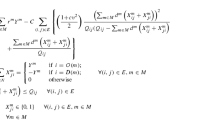Abstract
Call admission control with two classes of users is investigated via a nonlinear stochastic knapsack model. The feasibility region represents the subset of the call space, where given constraints on the quality of service have to be satisfied. Admissible strategies are searched for within the class of coordinate-convex policies. Structural properties that the optimal policies belonging to such a class have to satisfy are derived. They are exploited to narrow the search for the optimal solution to the nonlinear stochastic knapsack problem that models call admission control. To illustrate the role played by these properties, the numbers of coordinate-convex policies by which they are satisfied are estimated. A graph-based algorithm to generate all such policies is presented.











Similar content being viewed by others
Notes
This is different from the generalized stochastic knapsack problem considered in [6, Chapter 3].
The notation used here is slightly different from the one of [1], where a distinction among “type-\(1\) corner points,” “type-\(2\) corner points,” and “corner points” is made.
Not every combination of points in the grid is a feasible choice as a corner points. Indeed, by Definition 3.1 and the coordinate-convexity of \(\Omega \), no two corner points can be on the same vertical or horizontal lines.
Recall that a monotonic path (see also [20]) is a path that starts in the upper-left corner, finishes in the lower-right corner, and consists entirely of edges pointing rightward or downward.
References
Ross, K., Tsang, D.: The stochastic knapsack problem. IEEE Trans. Commun. 37(7), 740–747 (1989)
Kleywegt, A.J., Papastavrou, J.D.: The dynamic and stochastic knapsack problem with random sized items. Oper. Res. 49(1), 26–41 (2001)
Dean, B.C., Goemans, M.X., Vondrak, J.: Approximating the stochastic knapsack problem: the benefit of adaptivity. Math. Oper. Res. 33(4), 945–964 (2008)
Keller, H., Pferschy, U., Pisinger, D.: Knapsack Problems. Springer, Berlin Heidelberg (2004)
Kesidis, G., Walrand, J., Chang, C.S.: Effective bandwidths for multiclass Markov fluids and other ATM sources. IEEE ACM Trans. Netw. 1(4), 424–428 (1993)
Ross, K.W.: Multiservice Loss Models for Broadband Telecommunication Networks. Springer, New York (1995)
Aswakul, C., Barria, J.: Analysis of dynamic service separation with trunk reservation policy. IEE Proc. Commun. 149(1), 23–28 (2002)
Guerin, R., Ahmadi, H., Naghshineh, M.: Equivalent capacity and its application to bandwidth allocation in high-speed networks. IEEE J. Sel. Areas Commun. 9(7), 968–981 (1991)
Tse, D., Gallager, R., Tsitsiklis, J.: Statistical multiplexing of multiple time-scale Markov streams. IEEE J. Sel. Areas Commun. 13(6), 1028–1038 (1995)
Javidi, T., Teneketzis, D.: An approach to connection admission control in single-hop multiservice wireless networks with QoS requirements. IEEE Trans. Veh. Technol. 52(4), 1110–1124 (2003)
Cello, M., Gnecco, G., Marchese, M., Sanguineti, M.: Structural properties of optimal coordinate-convex policies for CAC with nonlinearly-constrained feasibility regions. In: Proceedings of IEEE INFOCOM’11 Mini-Conf., pp. 466–470 (2011)
Cello, M., Gnecco, G., Marchese, M., Sanguineti, M.: CAC with nonlinearly-constrained feasibility regions. IEEE Commun. Lett. 15(4), 467–469 (2011)
Dasylva, A., Srikant, R.: Bounds on the performance of admission control and routing policies for general topology networks with multiple call classes. In: Proceedings of IEEE INFOCOM’99, vol. 2, pp. 505–512 (1999)
Cello, M., Gnecco, G., Marchese, M., Sanguineti, M.: Optimality conditions for coordinate-convex policies in CAC with nonlinearly feasibility boundaries. IEEE ACM Trans. Netw. 21(5), 1363–1377 (2013)
Hörmander, L.: Notions of Convexity. Birkäuser, Boston (2007)
Likhanov, N., Mazumdar, R.R., Theberge, F.: Providing QoS in large networks: Statistical multiplexing and admission control. In: Boukas, E., Malhame, R. (eds.) Analysis, Control and Optimization of Complex Dynamic Systems, pp. 137–167. Kluwer (2005)
Barnhart, C., Wieselthier, J., Ephremides, A.: An approach to voice admission control in multihop wireless networks. In: Proceedings of IEEE INFOCOM’93, vol. 1, pp. 246–255 (1993)
Bolla, R., Davoli, F., Marchese, M.: Bandwidth allocation and admission control in ATM networks with service separation. IEEE Commun. Mag. 35(5), 130–137 (1997)
Little, J.D.C.: A proof for the queuing formula: \(l= \lambda w\). Oper. Res. 9(3), 383–387 (1961)
Stanley, R.P.: Enumerative Combinatorics, vol. 2. Cambridge University Press, Cambridge (1999)
Comtet, L.: Advanced Combinatorics: the Art of Finite and Infinite Expansions. Kluwer, Amsterdam (1974)
Acknowledgments
G. Gnecco and M. Sanguineti were supported by the Gruppo Nazionale per l’Analisi Matematica, la Probabilitàe le loro Applicazioni (GNAMPA) of the Istituto Nazionale di Alta Matematica (INdAM). M. Sanguineti was also supported by the Progetto di Ricerca di Ateneo 2013, granted by the University of Genoa.
Author information
Authors and Affiliations
Corresponding author
Rights and permissions
About this article
Cite this article
Cello, M., Gnecco, G., Marchese, M. et al. Narrowing the Search for Optimal Call-Admission Policies Via a Nonlinear Stochastic Knapsack Model. J Optim Theory Appl 164, 819–841 (2015). https://doi.org/10.1007/s10957-014-0570-2
Received:
Accepted:
Published:
Issue Date:
DOI: https://doi.org/10.1007/s10957-014-0570-2
Keywords
- Stochastic knapsack
- Nonlinear constraints
- Call admission control
- Coordinate-convex policies
- Structural properties




